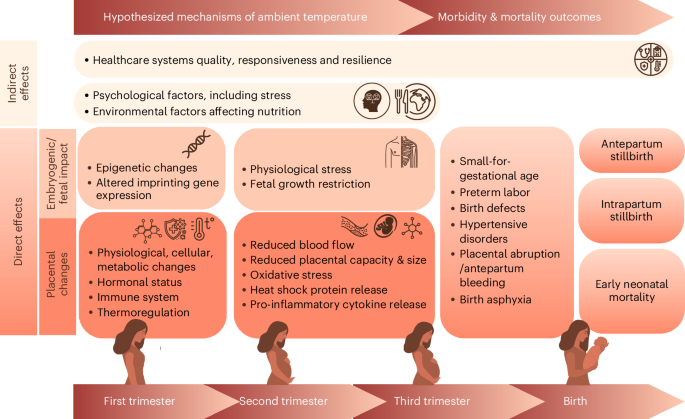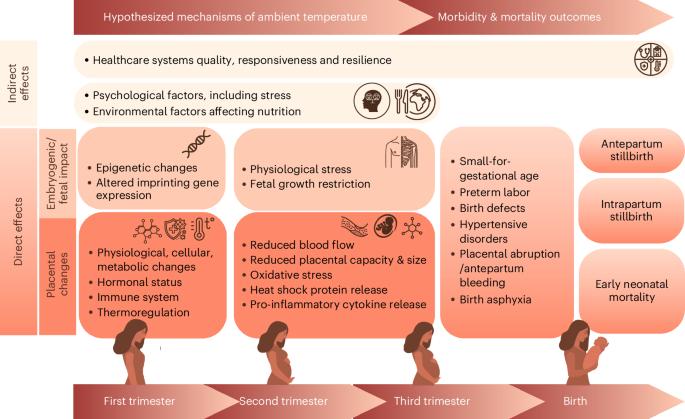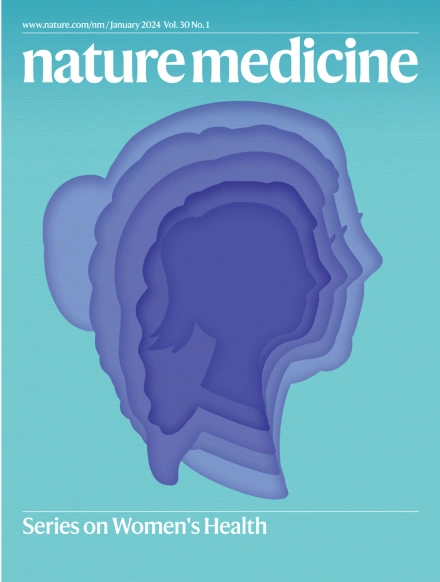A time-stratified, case–crossover study of heat exposure and perinatal mortality from 16 hospitals in sub-Saharan Africa
IF 58.7
1区 医学
Q1 BIOCHEMISTRY & MOLECULAR BIOLOGY
引用次数: 0
Abstract
Growing evidence suggests that extreme heat events affect both pregnant women and their infants, but few studies are available from sub-Saharan Africa. Using data from 138,015 singleton births in 16 hospitals in Benin, Malawi, Tanzania and Uganda, we investigated the association between extreme heat and early perinatal deaths, including antepartum and intrapartum stillbirths, and deaths within 24 h after birth using a time-stratified case–crossover design. We observed an association between an increase from the 75th to the 99th percentile in mean temperature 1 week (lag 0–6 d) before childbirth and perinatal mortality (odds ratio (OR) = 1.34 (95% confidence interval (CI) 1.01–1.78)). The estimates for stillbirths were similarly positive, but CIs included unity: OR = 1.29 (95% CI 0.95–1.77) for all stillbirths, OR = 1.18 (95% CI 0.71–1.95) for antepartum stillbirths and OR = 1.64 (95% CI 0.74–3.63) for intrapartum stillbirths. The cumulative exposure–response curve suggested that the steepest slopes for heat for intrapartum stillbirths and associations were stronger during the hottest seasons. We conclude that short-term heat exposure may increase mortality risks, particularly for intrapartum stillbirths, raising the importance of improved intrapartum care. Data collected from 138,015 hospital-based singleton births in four sub-Saharan African countries revealed an association between heat exposure in the week leading up to the birth and perinatal mortality.


撒哈拉以南非洲 16 家医院热暴露与围产期死亡率的时间分层病例交叉研究
越来越多的证据表明,极端高温事件对孕妇和婴儿都有影响,但撒哈拉以南非洲地区的研究却很少。我们利用贝宁、马拉维、坦桑尼亚和乌干达 16 家医院 138,015 例单胎新生儿的数据,采用时间分层病例交叉设计,研究了极端高温与围产期早期死亡(包括产前和产中死胎)以及产后 24 小时内死亡之间的关系。我们观察到,分娩前 1 周(滞后 0-6 d)平均气温从第 75 百分位数升高至第 99 百分位数与围产期死亡率之间存在关联(几率比 (OR) = 1.34(95% 置信区间 (CI) 1.01-1.78))。死胎的估计值同样为正,但 CI 包括统一值:所有死胎的 OR = 1.29(95% CI 0.95-1.77),产前死胎的 OR = 1.18(95% CI 0.71-1.95),产中死胎的 OR = 1.64(95% CI 0.74-3.63)。累积暴露-反应曲线表明,在最炎热的季节,产前死胎的热斜率最陡,相关性也更强。我们的结论是,短期暴露于高温可能会增加死亡风险,尤其是产中死胎,因此改善产中护理非常重要。
本文章由计算机程序翻译,如有差异,请以英文原文为准。
求助全文
约1分钟内获得全文
求助全文
来源期刊

Nature Medicine
医学-生化与分子生物学
CiteScore
100.90
自引率
0.70%
发文量
525
审稿时长
1 months
期刊介绍:
Nature Medicine is a monthly journal publishing original peer-reviewed research in all areas of medicine. The publication focuses on originality, timeliness, interdisciplinary interest, and the impact on improving human health. In addition to research articles, Nature Medicine also publishes commissioned content such as News, Reviews, and Perspectives. This content aims to provide context for the latest advances in translational and clinical research, reaching a wide audience of M.D. and Ph.D. readers. All editorial decisions for the journal are made by a team of full-time professional editors.
Nature Medicine consider all types of clinical research, including:
-Case-reports and small case series
-Clinical trials, whether phase 1, 2, 3 or 4
-Observational studies
-Meta-analyses
-Biomarker studies
-Public and global health studies
Nature Medicine is also committed to facilitating communication between translational and clinical researchers. As such, we consider “hybrid” studies with preclinical and translational findings reported alongside data from clinical studies.
 求助内容:
求助内容: 应助结果提醒方式:
应助结果提醒方式:


